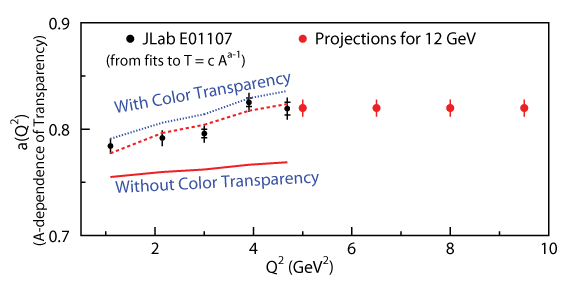
INSTITUTE FOR NUCLEAR THEORY
News
Home | Contact | Search | News archive | Site Map

|
INSTITUTE FOR NUCLEAR THEORY News
Home | Contact | Search | News archive | Site Map |
|||||
The Jefferson Laboratory Upgrade to 12 GeV
The program on the The Jefferson Laboratory Upgrade
to 12 GeV was held at the INT from September 14 to October 16, and from October
26 to November 20, 2009. The immediate goal was to bring experimentalists
and theorists together to explore and develop important aspects of the
exciting physics possibilities.
This goal was well achieved, as the program brought together a wide
variety of about 100 experimentalists and theorists (almost 50%
experimentalists) to work together during the nine-weeks of the program.
Several presentations were adjusted, and in some cases completely new talks were
drafted, as a follow-up to lively discussions on experimental possibilities.
Several new experimental proposals were discussed, and some of these
have already been
submitted to the JLab Program Advisory Committee.
Discussions on a few followup workshops or topical meetings are ongoing, and
several new collaborations originated from this INT program. Overall,
we believe
that the rich interactions
between theorists and experimentalists in a positive and productive
atmosphere led to a very productive program.
Pionic color transparency, measured in the nuclear e,e'π reaction.
The program was organized into three categories, following the unique opportunities
allowed by this Upgrade through its combination of luminosity, duty factor and
kinematic reach, which are foreseen to make profound contributions
to the study of hadronic matter.
Determining the spin and flavor generalized parton distributions and transverse
momentum distributions, of the valence quarks that reside in the nucleon. This would
culminate in nucleon tomography measurements to discover the true three-dimensional
structure of nucleons. Major progress was made to bring the, often distinct, communities
interested in both distributions together, discuss commonalities and pitfalls in the
frameworks, and raise questions about the validity of various factorization schemes.
Elucidating possibilities to make headway in extracting and interpreting these
distributions was a major theme.
This activity occured during the period of 9/14 to
10/16, including a dedicated one-week workshop during the first week. Nuclear effects. Measurements using nuclear targets with the Upgrade will allow
unprecedented access to the role of valence quarks in nuclei, and the dynamical process
by which such quarks propagate through the nuclear medium and form hadrons. Many talks
discussed novel ways to investigate the nuclear EMC effect, discovered
some 25 years ago. The effect is that the momentum distribution of
valence quarks inside the nuclei differs, notably in the valence region, from
that of quarks in a free nucleon. To date, there are hundreds of papers on this subject,
but no universally accepted explanation. Using the high luminosity at 12 GeV, would allow
experimentalists and theorists multiple ways to disentangle the
different suggested causes of the EMC effect and their consequences
for other processes. The effects
of color transparency and short-range nucleon-nucleon correlations are closely related
to these topics and also formed focus points of the program. An
example, of the potential impact of the Upgrade on measurements of
color transparency is shown in the accompanying figure. This activity spanned the
period of 10/26-11/06. The search for exotic mesons using high energy photon-proton collisions.
Fluctuations of the gluonic vacuum are an unavoidable part of the structure of mesons.
A new generation of hadron spectroscopy experiments and theoretical investigations was
discussed to allow the search for exotic hadrons and investigate various puzzles
involving mesonic and baryonic spectra. Finding such exotic hadrons and determining
their spectrum will unambiguosly underline the role of gluon self-interactions
in hadrons, and provide the basis for understanding the confinement mechanism
that eternally locks quarks and gluons in hadrons. To make substantial progress,
it is vital that theorists concerned with the physics of reaction mechanisms work with
experimentalists to understand the relevant energy-dependent physics backgrounds that
could mimic potential signals of a resonant state. This was exactly the topic of a
dedicated workshop held Nov. 9-13 that was followed by another week of intense discussions
amongst theorists and experimentalists on the ins and outs of Partial Wave Analysis methods.
Plans were developed to produce a White Paper.
(INT program September 14 - October 16 & October 26 - November 20, 2009)
Reported by Carlos Munoz Camacho, Rolf Ent, Jerry Miller, and Tony Thomas
Date posted February 12, 2010
![]()
